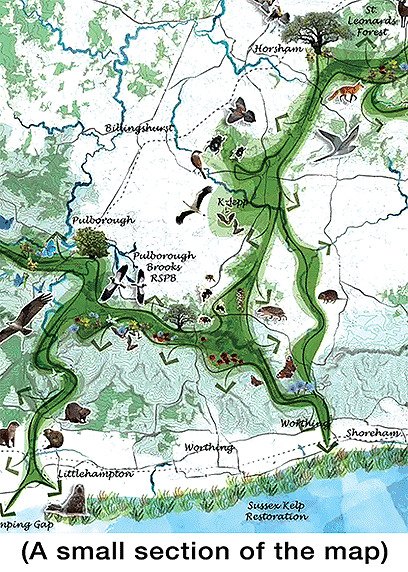Weald to Waves
Monday 30th October Let’s do the bad news first; we are in the midst of a biodiversity crisis. This is not just something that is happening in the Amazon Forest, or about iconic creatures like polar bears hunting off floating Artic Sea ice. The crisis is here on our doorstep; with large numbers of our native species in decline. Birds, mammals, reptiles, invertebrates; everything that flies, crawls, swims, moves, at every level of the food chain is in trouble and facing an uncertain future. And the sad truth is, that Britain is among the most nature depleted countries on this, our planet.
Let’s do the bad news first; we are in the midst of a biodiversity crisis. This is not just something that is happening in the Amazon Forest, or about iconic creatures like polar bears hunting off floating Artic Sea ice. The crisis is here on our doorstep; with large numbers of our native species in decline. Birds, mammals, reptiles, invertebrates; everything that flies, crawls, swims, moves, at every level of the food chain is in trouble and facing an uncertain future. And the sad truth is, that Britain is among the most nature depleted countries on this, our planet. The causes are many and complex; agricultural management of the land, climate change, the loss of wetlands and pristine freshwater habitats, urbanization, pollution, woodland management, invasive non-native species. In a word; us
The future for our wildlife looks bleak. A glass filled with gloom and darkness and despondency.
And then something happens, a spark, a light, and suddenly the glass clears and the future looks brighter.
An idea, a group of people can change things, turn things around and create something better, something remarkable.
‘Weald to Waves’ could be that idea, that group of people, shaping a better future not just for our wildlife but for us who depend on it for our own survival.
‘Weald to Waves’ is an ambitious project created to establish not one, not two, but three wildlife corridors running from Ashdown Forest through the Knepp Estate on the High Weald, along the river valleys of the Arun, Adur and Ouse, and down to the coast. Vital corridors that will enable our local wildlife to move easily from one area to another, spreading down through Sussex, improving our local biodiversity.
The project, co-ordinated by Libby Drew from the Knepp Wildland Foundation, has the support of Natural England, the South Downs National Park, The Sussex Wildlife Trust, and Wakehurst Kew. Falling under its umbrella are ongoing conservation projects like the Sussex Kelp Restoration Project and Wilder Horsham. The planned 100-mile corridor will include parts of Ashdown Forest and land on the Barlavington and Wiston Estates.
Farmers and landowners are being urged to pledge all or part of their land to form part of the corridor. It is hoped that over 20,000 hectares of land will be registered as contiguous natural habitat.
And it is not just about landowners and conservation organisations, the most important thing about this project is that we can all be part of this. We can all play a role, either through our local community, our local councils or as individuals, in helping our local wildlife to thrive
To help us do this ‘Weald to Waves’ has created a Gardens and Greenspaces Network, encouraging people like you and I to sign up to transform our outdoor space, be it a garden, a park, a playgroup, an allotment, a churchyard, a verge, or a village green into a wildlife friendly area that becomes a stepping stone in the corridor they are hoping to create.
If you would like to learn more about the ‘Weald to Waves’ project, and how you can be part of it, come along to Greening Steyning’s monthly Green Drinks at the Steyning Centre on the 30th October, 2023 at 19:30.